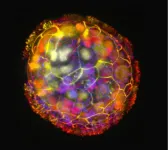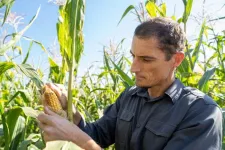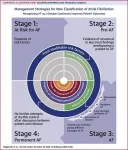(Press-News.org) BUFFALO, N.Y. --- Scleractinian corals, or hard corals, have been disappearing globally over the past four decades, a result of climate change, pollution, unsustainable coastal development and overfishing. However, some Caribbean octocorals, or soft corals, are not meeting the same fate.
During a two-year survey of soft corals in the Florida Keys, Mary Alice Coffroth, professor emerita of geology at the University at Buffalo, along with a small team of UB researchers, identified three species of octocorals that have survived heat waves. While the coral animal itself may be heat tolerant, Coffroth said that her team concluded that the symbiotic algae inside the coral serve as a protector of sorts.
“The resistance and resilience of Caribbean octocorals offers clues for the future of coral reefs,” Coffroth said.
A recent paper outlining their research, “What makes a winner? Symbiont and host dynamics determine Caribbean octocoral resilience to bleaching,” was published on Nov. 22, in Science Advances by the American Association for the Advancement of Science (AAAS).
Coffroth is the lead author on the study she conducted between 2015 and 2017 with graduate student Louis Buccella, undergraduates Katherine Eaton and Alyssa Gooding and technician Harleena Franklin. Howard Lasker, professor emeritus in the departments of Environment and Sustainability and Geology, also contributed to the study.
Algae helps corals survive heat waves
Both hard and soft coral depend on a nutritional symbiosis with single-celled algae living within their tissues. Warmer waters can cause the symbiosis to break down, resulting in a loss of the algal symbionts, which turns the corals white, a phenomenon known as bleaching.
“Bleaching can lead to coral death,” said Coffroth, who has studied coral reefs in the Florida Keys since 1998, including a more recent study in 2020-21. “It’s unclear if the algae leave or are ejected from the coral.
“In this study, we examined possible mechanisms that contribute to the heightened resistance and resilience of three octocoral species in the face of the recurring marine heat waves leading to bleaching events,” Coffroth said, noting that this is the first study that follows both symbiont genetic makeup and density in Caribbean octocorals before, during and after a major heat wave.
By and large, Caribbean octocorals harbor symbionts within the genus Breviolum, she said. And this symbiont is helping to make the octocoral better able to handle the rising heat.
“The Breviolum densities declined during the heatwaves but recovered quickly,” she explained. “Octocoral mortality was low compared to their scleractinian relatives.”
2014 El Niño prompted research
When Coffroth saw bleached corals during the 2014 El Niño and knew that a similar event was predicted for the following summer, she applied for a Rapid Response Research (RAPID) grant from the National Science Foundation. She was awarded $56,305 and with her master’s student, Buccella, conducted the study in the Keys, following the fate of the octocorals and their symbionts for 28 months.
She and other members of the team made trips to the Keys Marine Lab at the Florida Institute of Oceanography to study the octocorals in the spring and fall of 2015 and 2016 and spring and summer of 2017, recording coral coloration and taking samples to study density of the symbionts and their genetic identity.
“We knew it was critical to follow individual colonies across an event with long-term monitoring of both host and symbiont responses,” she said, “and to examine the response at least at the level of symbiont species, if not the genotype, to identify potentially resilient species.”
Climate change moving faster than coral evolution
Although the study began almost a decade ago, Coffroth said the findings are extremely relevant because they mirror what is happening right now, with the continuing warming of ocean waters, increased storms and major bleaching events across the globe.
“There is evidence that corals are withstanding higher temperature now than they did in the 1960s,” she said. “That signals evolution, but the problem is that climate change is moving too fast, faster than evolution.”
In addition to their beautiful aesthetics, coral reefs provide many benefits to the planet and its inhabitants, including barriers to coastal regions that are susceptible to hurricanes and other tropical storms; habitat for large fish such as grouper and snapper; a tourist destination for snorkeling, fishing and diving; and a source for bioactive compounds used in drugs to treat inflammation and certain kinds of cancer.
“If you a see picture of coral reefs when I started diving in the 1970s and compare it with one now, it makes you want to cry,” she said. “The change is just amazing.”
While she noted that this study has some important observations, further study is needed to better understand what is happening to the ecosystem.
“I’m seeing species bleach that have never bleached before but also ones showing more resilience,” she said. “There is a lot of variation within both the animal and symbiont genera. We need to understand the variation.”
The hope is to continue research into coral reef relationships and the durability of the symbiotic algae while also taking steps to halt the damage to the environment by human action, such as overfishing and the burning of fossil fuels.
“We can’t stop global warming,” Coffroth said. “But the hope is that we can slow it down.”
END
Study identifies key algae species helping soft corals survive warming oceans
The algae, from the genus Breviolum, resides inside the coral tissue, forming a symbiotic relationship
2023-11-30
ELSE PRESS RELEASES FROM THIS DATE:
Scientists build tiny biological robots from human cells
2023-11-30
Researchers at Tufts University and Harvard University’s Wyss Institute have created tiny biological robots that they call Anthrobots from human tracheal cells that can move across a surface and have been found to encourage the growth of neurons across a region of damage in a lab dish.
The multicellular robots, ranging in size from the width of a human hair to the point of a sharpened pencil, were made to self-assemble and shown to have a remarkable healing effect on other cells. The discovery is a starting point for the researchers’ vision to use patient-derived ...
Smart microgrids can restore power more efficiently and reliably in an outage
2023-11-30
It’s a story that’s become all too familiar — high winds knock out a power line, and a community can go without power for hours to days, an inconvenience at best and a dangerous situation at worst. UC Santa Cruz Assistant Professor of Electrical and Computer Engineering Yu Zhang and his lab are leveraging tools to improve the efficiency, reliability, and resilience of power systems, and have developed an artificial intelligence (AI) -based approach for the smart control of microgrids for power ...
Unsafe lead levels in school drinking water: new UMass Amherst study IDs building risk factors
2023-11-30
AMHERST, Mass. – University of Massachusetts Amherst civil and environmental engineers have determined the factors that may help identify the schools and daycare centers at greatest risk for elevated levels of lead in drinking water. The most telling characteristic for schools in Massachusetts is building age, with facilities built in the 1960s and 1970s—nearly a third of the facilities tested—at the greatest risk for having dangerously high water lead levels.
There is no safe exposure ...
Chinstrap penguins asleep thousands of times per day, but only for seconds at a time
2023-11-30
In the wild, nesting chinstrap penguins get more than 11 hours of sleep per day – but not all at once. According to a new study, these birds nod off thousands of times per day, but for only around 4 seconds at a time, cumulatively accruing their daily sleep needs while remaining continuously vigilant over their nests. Sleep seems to be ubiquitous throughout the animal kingdom. Typically characterized by immobility and the relative loss of ability to sense and respond to the surrounding environment, sleep can render animals vulnerable to predation. In humans, insufficient sleep can lead to nodding off, the seconds-long interruption of wakefulness by eye closure, and sleep-related ...
A Neptune-mass exoplanet found closely orbiting a very low-mass M dwarf star
2023-11-30
The discovery of a Neptune-mass exoplanet orbiting the very low-mass M dwarf star LHS 3154 challenges theoretical models of planet formation, according to a new study. The planet, which has a mass at least 13 times that of Earth, tightly orbits a star 9 times less massive than the Sun, demonstrating that small stars can sometimes host larger planets than was previously thought. Planets form in the dense circumstellar discs of gas and dust that surround newborn stars. The amount of material in these structures determines how massive the planets that form ...
Two teosintes made modern maize
2023-11-30
Broad genetic sampling of maize and its teosinte grass ancestors reveals evidence of wild admixture during the crop’s initial domestication and dispersal, according to a new study. The findings clarify the contentious origin of modern maize and raise new questions about the anthropogenic mechanisms underlying its spread throughout the Americas. The domestication of crops transformed human culture. For many crops, the wild plants that modern domesticates are most closely related to can be readily identified by morphological and genetic similarities. Yet, despite its global agricultural importance, the ancestry of modern maize has long ...
A mixed origin made maize successful
2023-11-30
Maize is one of the world’s most widely grown crops. It is used for both human and animal foods and holds great cultural significance, especially for indigenous peoples in the Americas. Yet despite its importance, the origins of the grain have been hotly debated for more than a century. Now new research, published Dec. 1 in Science, shows that all modern maize descends from a hybrid created just over 5000 years ago in central Mexico, thousands of years after the plant was first domesticated.
The ...
Discovery of planet too big for its sun throws off solar system formation models
2023-11-30
UNIVERSITY PARK, Pa. – The discovery of a planet that is far too massive for its sun is calling into question what was previously understood about the formation of planets and their solar systems, according to Penn State researchers.
In a paper published online today (Nov. 30) in the journal Science, researchers report the discovery of a planet more than 13 times as massive as Earth orbiting the “ultracool” star LHS 3154, which itself is nine times less massive than the sun. The mass ratio of the newly found planet with its host star is more than 100 times higher than that of Earth and the sun.
The finding reveals the most massive known ...
Early rhythm control, lifestyle modification and more tailored stroke risk assessment are top goals in managing atrial fibrillation
2023-11-30
The American College of Cardiology (ACC) and the American Heart Association (AHA), along with several other leading medical associations, have issued a new guideline for preventing and optimally managing atrial fibrillation (AFib). The guideline was jointly published today in the Journal of the American College of Cardiology and Circulation.
Atrial fibrillation, or AFib, is the most common type of heart rhythm disorder (arrhythmia), affecting over 6 million Americans, and the number is expected to double by 2030. AFib causes a variety of symptoms, including fast ...
Carbon dioxide becomes more potent as climate changes, study finds
2023-11-30
Embargoed: Not for Release Until 2:00 pm U.S. Eastern Time Thursday, 30 November 2023.
A team of scientists found that carbon dioxide becomes a more potent greenhouse gas as more is released into the atmosphere.
The new study, led by scientists at the University of Miami Rosenstiel School of Marine, Atmospheric, Science, was published in Science and comes as world leaders meet in Dubai, United Arab Emirates, this week for the United Nations Climate Change Conference COP28.
“Our finding means that ...
LAST 30 PRESS RELEASES:
Mount Sinai Health system receives $8.5 million NIH grant renewal to advance research on long-term outcomes in children with congenital heart disease
Researchers develop treatment for advanced prostate cancer that could eliminate severe side effects
Keck Medicine of USC names Christian Pass chief financial officer
Inflatable fabric robotic arm picks apples
MD Anderson and SOPHiA GENETICS announce strategic collaboration to accelerate AI-driven precision oncology
Oil residues can travel over 5,000 miles on ocean debris, study finds
Korea University researchers discover that cholesterol-lowering drug can overcome chemotherapy resistance in triple-negative breast cancer
Ushikuvirus: A newly discovered giant virus may offer clues to the origin of life
Boosting the cell’s own cleanup
Movement matters: Light activity led to better survival in diabetes, heart, kidney disease
Method developed to identify best treatment combinations for glioblastoma based on unique cellular targets
Self-guided behavioral app helps children with epilepsy sleep earlier
Higher consumption of food preservatives is associated with an increased risk of type 2 diabetes
NTU Singapore-led team captures first-ever ‘twitch’ of the eye’s night-vision cells as they detect light, paving the way for earlier detection of blindness-causing diseases
Global aviation emissions could be halved through maximising efficiency gains, new study shows
Fewer layovers, better-connected airports, more firm growth
Exposure to natural light improves metabolic health
As we age, immune cells protect the spinal cord
New expert guidance urges caution before surgery for patients with treatment-resistant constipation
Solar hydrogen can now be produced efficiently without the scarce metal platinum
Sleeping in on weekends may help boost teens’ mental health
Study: Teens use cellphones for an hour a day at school
After more than two years of war, Palestinian children are hungry, denied education and “like the living dead”
The untold story of life with Prader-Willi syndrome - according to the siblings who live it
How the parasite that ‘gave up sex’ found more hosts – and why its victory won’t last
When is it time to jump? The boiling frog problem of AI use in physics education
Twitter data reveals partisan divide in understanding why pollen season's getting worse
AI is quick but risky for updating old software
Revolutionizing biosecurity: new multi-omics framework to transform invasive species management
From ancient herb to modern medicine: new review unveils the multi-targeted healing potential of Borago officinalis
[Press-News.org] Study identifies key algae species helping soft corals survive warming oceansThe algae, from the genus Breviolum, resides inside the coral tissue, forming a symbiotic relationship





